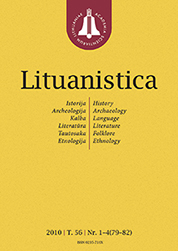LituanisticaWHAT?
 ISSN 0235-716X |
2005 m. Nr. 4 Vardažodžių, įvardžių ir jų gramatinių formų vartojimas lietuvių kalbos stiliuose
The aim of the study was to compare the usage of nominals and their grammatical forms in the texts of scientific, professional, journalese and fiction styles of Lithuanian language and to discuss differences and similarities of their usage as only a omparison may best of all reveal the real situation. Such comparison is certainly correct, as it was carried out on the basis of computerised iterative dictionaries of scientific, professional, journalese and fiction styles (Grumadiene, Zilinskiene 1996) compiled using the same methods and the same amount (300 000) of words in the texts published during 1990–1995 in Lithuania.
The following conclusions have been drawn: Nominals in the texts of scientific, professional, journalese and fiction styles, respectively, comprise 63.34%, 62.34%, 56.54% and 48.25%; this is mainly determined by the usage of nouns and adjectives. The most frequently used part of speech in the texts of comparative styles is the noun. There are less nouns in fiction than in the texts of professional or scientific styles, and journalese texts in this respect take an intermediate position. The usage of adjectives in the texts differs. Most frequently adjectives are used in scientific style and least in fiction texts. Pronouns, in contrast to nouns and adjectives, are least used in scientific texts and almost twice more often in fiction. In all the texts, forms of masculine gender of all nominals are more frequent than feminine ones. The usage of gender forms in the texts of all styles differs slightly, except the neuter gender forms of adjectives. In the texts of all the four styles, singular forms of all nominals are more frequent than plural ones. The usage of these forms slightly differs in the texts of different styles, except that singular forms of adjectives and pronouns are slightly more frequent in fiction. Cases of all nominals in the texts of all the styles (except vocative) according to the usage rate fall into two groups: main (genitive, nominative, accusative) and peripheral (locative, instrumental and dative). However, the usage of specific cases in the texts of comparative styles differs. Most of all differs the usage of the nominative and genityve cases of all nominals (except ordinal numerals) in the texts of fiction style. According to the usage of the discussed grammatical forms of all parts of speech, scientific and professional texts exhibit little difference, the more distinct being the fiction style, and journalese takes an intermediate position. |
Numeriai:
2011 - T.57 Nr.1, Nr.2, Nr.3, Nr.4 2010 - T.56 Nr.1-4 2009 - T.55 Nr.1-2, Nr.3-4 2008 - T.54 Nr.1, Nr.2, Nr.3, Nr.4 2007 - T.53 Nr.1, Nr.2, Nr.3, Nr.4 2006 Nr.1, Nr.2, Nr.3, Nr.4 2005 Nr.1, Nr.2, Nr.3, Nr.4 2004 Nr.1, Nr.2, Nr.3, Nr.4 2003 Nr.1, Nr.2, Nr.3, Nr.4 2002 Nr.1, Nr.2, Nr.3, Nr.4 2001 Nr.1, Nr.2, Nr.3, Nr.4 |